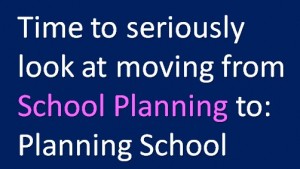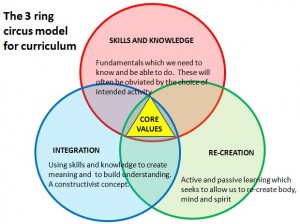The recent ACEC 2010 conference in Melbourne was interesting from a range of perspectives. Disappointingly, I became more and more and more dismayed at the perpetuation of a number of dominant paradigms.
Prominent amongst these was the view that the failure of our schools to change to has been largely the responsibility of a range of successive policy makers, governments, management, bureaucrats and, basically anybody not ‘at the coalface’ of teaching. Predictably, the biggest laughs came from the heavy criticism of government policies at both state and federal levels, and in the heady ideals from the seventies, and the belief that the very people who had assisted the rise of these ideas to prominence were now actively proceeding, blinkered and in step, to pull the truck of an ideology which would seek to turn all children into complicit cogs for the machine.
And, you’ll need to allow me a wry grin here when we stop and think that much of this glee and anti-establishment rhetoric was coming from people whose livelihood is derived from working for establishments which value their uniform policy, which suspend girls who have the wrong coloured hair, who know that their faith policies may include profession of religious views which could provoke hatred in various parts of the globe, or lead to significant reduction in the rights of women or other groups, or which have, in the past, decried public schools for their humanist approaches to individual choice making which are divergent from the truth of gospel.
All of these schools have an absolute right to exist in my opinion. The fact that they can relies, however, on exactly those taxpayers, of all sizes, shapes, colours and faiths, who in turn elect governments who provide a very significant portion of their funding. This guaranteed funding then enables the creation of budget models which can adjust additional income through fee increases and plan for surpluses which can fund an ongoing cycle of improvements. After then actively discriminating, in their employment policies, against anyone who cannot produce a suitable evidence of their ethos compatibility, it would be nice if they had the decency to see a little more of the forest which is the realm of public opinion and the broad spectrum of a very diverse modern Australian; and less of the separate trees which they have the opportunity to shape in ways which suit themselves, and their customers.
There was loud applause for widespread criticism of the National Curriculum, for NAPLAN, for the Digital Education Revolution, for Victoria’s Ultralab, Queensland’s Digital Pedagogy Licence etc, and for the general idea that governments basically always have it wrong.
Whether they are right or wrong, the policies which were planned for implementation were put on the table very publicly prior to the last round of elections. In Australia, we all vote.
It’s like sitting in a pub, in the fug and swill of an after-work session and overhearing the conversations which so often default to the age old laughter and derision to those in the ‘boss’ classes, who invariably ‘wouldn’t have a clue,’ are ‘all brains and no common sense,’ or who are ‘only concerned about putting something on their CV’ etc. This seems fairly usual group behaviour, but we should always remember that everybody started somewhere sometime.
It is also useful to remember that: titles and positions aside, we are all human beings. We all, as a former leader of mine said, “put our pants on the same way in the morning.”
Sometimes we need to hold a mirror up to our own paradigms. Just as it is unreasonable for ‘the system’ to assume that every person ‘at the coalface’ of teaching, is trying their best to do as little as possible and therefore needs to be whipped into shape with some good testing regimes and performance management systems, may it not be a bit unfair to assume that every person at a management level is spending all of their days planning ways to make life difficult for those ‘at the coalface.?’
‘At the coalface’ is, for me an expression I fundamentally dislike in reference to teaching. While I fully understand the analogy, it simply serves to reinforce all of the stereotypes about organisational behaviour which grow from a labour oriented industrial model of the world. An interesting clinging to a paradigm which so many profess to be wanting to change through working in more student centred ways. Are students just so much coal that we dig? If, as a teacher, you want to be seen as a person who does more than process commodities, in a drudge of non-recognition and encouragement, then stop talking like a coalminer or process worker. We can all make choices about the mental models we apply to our world. Maybe that dude in the suit who’s one of those people from DET might just be a human being like you. Maybe they also like Twitter, or keyword searching on YouTube, or playing volleyball, golfing or building websites. Inappropriately applied paradigms are just as destructive from any direction.
Just for the record, we have many leaders in our system of education who have been trying different approaches for many years. Gary Stager and Seymour Papert may be interested to know that we were using 1:1 computers in a Juvenile Justice school in Sydney in 1985, with Apple 11e computers and Logo, along with wonderful text based story software like ‘Hitchhiker’s Guide to the Galaxy’ etc.
We might also like to remember that, in 1989, the ‘Schools Renewal’ report, or Scott Review, lead to some very significant changes, with the introduction of new structures, smaller school ‘clusters’, educational resource centres, acknowledgement of the growth of technology in schools, and calls for more localised approaches. Full implementation of the recommendations were thwarted, however, by hugely strident industrial opposition: the famous ‘Metherell Years.’ While policy makers and system leaders tried to move away from a centralist organisation and structure and provide a framework for greater engagement with priorities at local levels, teachers came out en masse to decry this direction.
After working as Teacher in Charge at a Juvenile Justice school and teaching myself how to program in Basic and Logo, to provide engagement for very troubled young offenders, I spent a year as a classroom teacher with limited access to a small lab of MicroBee computers and sporadic use of the one Apple 11e in the entire school to produce slideshows of student work using a technique which created a screen display which I have long ago forgotten.
Then, in 1988, in my first Principalship, at Broken Bay Sport and Recreation Centre, the efficacy of using a computer to assist the program booking process and information management became very obvious. The booking database I developed using Appleworks Database and its integration with the Wordprocessor module to mailmerge all correspondence, accident report cover letters etc was then scaled up to operate for all centres statewide by 1990. An upgrade to an Apple 11gs gave a bit more graphic ability, (we couldn’t afford a Mac), and we used this to create brochures to accompany environmental quests and information transfer.
One of my staff told me about Keylink in 1989 and, equipped with a new modem, it was good to be able to use a very primitive form of text based messaging, using the Austpac system with text which wiped onto the screen. Using Keylink, it was also possible to get involved in some of the first online OzProjects like Newsday. It was also possible to send faxes directly via Keylink, including outputting a spreadsheet list directly via fax.
In 1990, we hosted 140 teachers at Broken Bay Sport and Recreation Centre for a Computer Education Conference. The theme was ‘technology and the environment’ with significant input from the regional Aboriginal Education consultant and the Computer Consultancy team. Over 100 computers were manually loaded from a truck onto a ferry for a half hour trip to the Broken Bay wharf. They were then manhandled onto a tractor and trailer, then carried across a footbridge to another truck and then to the dining hall. Computer Consultant, Glenn Mullaney, had arranged for Telstra to provide an additional four phonelines which had to be physically provisioned across Patonga Creek and over the eastern ridge to the camp at Broken Bay. We had Keylink demos in the nurses quarters, Lego on the messhall verandahs, hypercard stacks in the lodges and, at night, lots of connection and fun.
We carried and lugged. The Sydney Morning Herald ran a story, under a headline which said, ‘And no Pac Man after lights out!’ about the use of Medical Forms intended for children sent to ‘campers.’ We did it because we believed this was important. It was, and it still is, and many are still trying to scaffold and support.
I remember taking a group to the beach to try an idea I had to develop Logo programs. One pair would write a program to describe a shape using basic sequential instructions eg Fwd 10; right 90; fwd 10 etc. Another pair would then be the turtle..using foot lengths as a unit and a stick as a pen to scribe a shape on the sand. We threw hoops onto grass and leaf-litter and did mini beast counts, tallying the data in spreadsheets.
It is possible to continue listing a whole range of ways that things have been tried to build environments which provide opportunities for students and which encourage shifts in pedagogy and in policy. There are many others who have continued to look for ways to work to make a difference. Don’t let us forget that system attempts, in the early years of the 21st century, to provide a platform for a range of web-services was met with bans by the union, operating with the majority support of teachers. Did those who speak loudest against the failure of the system to achieve change, speak up in their staffroom? Why does the union still use Faxstream as its primary communication format if not through fear of alienating non- email/internet users? No matter what the leadership vision might be for a school learning environment which is constructivist and flexible in approaching groupings and pedagogy to enable learners, there are still very strict processes in place around staffing schools, which were fought for by teachers themselves, as recently as last year.
There is much that is imperfect in a policy environment which bases itself on a fundamental principle of equitable provision, and the rollout of infrastructure and access. Yes, there may be better ways to finesse this. We can, however, point to the fact that students in Brewarrina have the same level of access to publicly provided ICT as students in Balmain. Our ‘fatcat’ bureaucrats have, in the DER NSW approach, handed a mass of resource to practitioners. Their way of doing it can be scoffed at by visiting experts, but the potential is there for the taking. I’m pleased to say that, if you put your hand up and say you’d like to have a go, if I can, I’ll do whatever I can to support you. Why not connect and collaborate at your staffroom level and gather a team who can then create something better and different through collaboration and mutually respectful relationships at all levels within your organisation. And, at the next social function or barbecue, why not speak up, and if necessary, seek to educate friends and community members about the urgent need we have to move from school planning to planning school. This is everybody’s business.
Please don’t let us, as people engaged in something much more important, allow ourselves to persist with exactly the paradigm entrenchment which we so vehemently criticise.







A friend, a colleague, a mother, a cousin, think of the range of things which describe who we are.
It is our affiliations which give meaning to who we are.








 withdraw its support for a system whereby doctors trained overseas, or overseas citizens who train in Australia, need to spend 10 years in rural and regional locations before being able to practise in major metro centres.
withdraw its support for a system whereby doctors trained overseas, or overseas citizens who train in Australia, need to spend 10 years in rural and regional locations before being able to practise in major metro centres. With the 2010 school year about to start, I thought I’d dust off some concepts and ideas from past years and put them together to focus some thinking on what proactive schools might be doing in the next little while. It only takes some reading from Twitter posts and elsewhere to see that the operating environment continues to evolve at an exponentially growing rate. This
With the 2010 school year about to start, I thought I’d dust off some concepts and ideas from past years and put them together to focus some thinking on what proactive schools might be doing in the next little while. It only takes some reading from Twitter posts and elsewhere to see that the operating environment continues to evolve at an exponentially growing rate. This 






Recent Comments